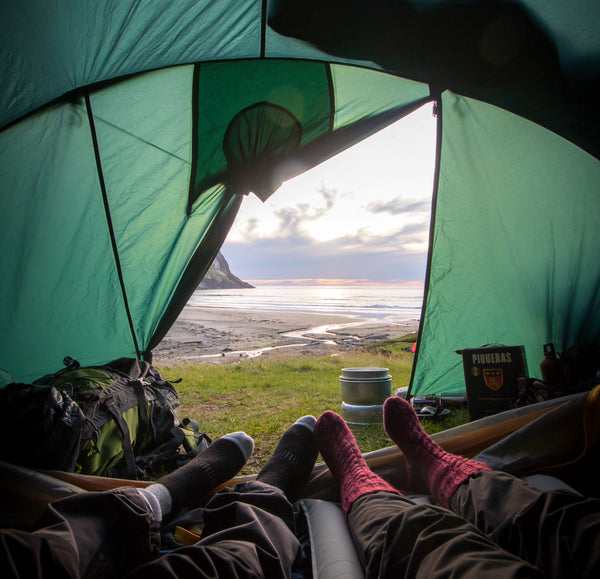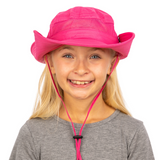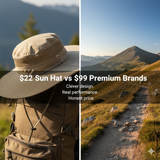
Wearing the right clothing materials would definitely add value to your hiking experience. You may end up saving a lot of money down the road. So let us dive into the basics and get you on that trail in comfort and style!
Table of Contents:
- What are the important factors when choosing hiking clothes?
- What are the basic essentials for hiking?
- What is the best underwear for hiking?
- What kind of shirt should I wear hiking?
- What pants should I wear hiking?
- What is the best jacket for hiking?
- What kind of socks are best for hiking?
- What kind of shoes are best for hiking?
- What is the best hat for hiking?
- How do I choose hiking gloves?
- How to dress for the weather in every season on a hike?
- What to wear hiking in the Spring and Fall season?
- How should I dress for a summer hike?
- What to wear hiking in the Winter?
- Conclusion
Important factors when choosing hiking clothing
These are some of the factors you need to consider when shopping for hiking clothes:
Your safety
Wearing the right hiking clothes is essential. The environment up in the mountains can fluctuate and you need to ensure that you have the right attire to adjust appropriately.
Your hiking clothes must be made of synthetic materials that can keep you dry as you start to sweat more. The clothing material must be soft, lightweight, and moisture-wicking.
Comfort level
Investing in moisture-wicking materials for your hiking clothes is important. Wicking materials move sweat away from the body—choose polyester, nylon, and merino wool. Plus, choose clothes with a looser fit that will provide you with more flexibility and comfort.
Clothing versatility
Choose clothing pieces that are versatile. Some of the best examples are lightweight hiking shirts with long sleeves that you can roll up and convertible pant legs that zip off into shorts.

Basic essentials
Now, let’s go down to the basics! Here are some of the basic clothing essentials you should get for your hiking expedition:
• Underwear
Choose breathable options that are made from a synthetic material, such as merino wool or polyester. Keep in mind that the fit is also important, so make sure that it’s snug and fits you perfectly. Last but not least, consider features such as tagless waistbands and flat seams.

• Shirts
When it comes to choosing shirts, look for wicking materials to keep you comfortable and dry. If you plan on being under the sun for the most part of the hike, the best shirt to wear is a long-sleeved one that is UPF-rated.

• Pants/Bottoms
Cargo pants and shorts are popular types of bottoms because they provide additional storage to stash your things. When it is extremely cold, fleece pants are a nice mid-layer addition.

• Jackets
Make sure that your jacket is packable, waterproof, and windproof. Polyester fleece jackets are best for colder conditions, while a rain jacket is, of course, best for soggy weather.

Jackets sporting “fleece” are typically made of polyester, which provides warmth while finding a combination of polyester and nylon materials instead can keep you warm and protect you from both rain and wind.
• Socks
Consider the height, cushioning, fabric, and fit when shopping for socks. Choose the right height by inspecting your footwear.
When it comes to cushioning, thicker socks may offer the best protection against debris and other elements on the trail, but they can cause your feet to sweat.

Wool is the most popular hiking sock material because it can regulate temperature to keep the feet from getting sweaty.
• Shoes
No matter how well a shoe is constructed, it will not function properly if it does not fit you well. To find the right fit, here are some of the factors you need to consider when choosing a pair of hiking shoes:
- Length from heel to toe
- Arch length
- Width of the foot
- Volume of the foot

• Hats
If it is going to be a warm hike and in the middle of the day,find a hat that will keep your head protected from UV rays and at the same time, protect your neck and face, too.
At GearTOP, we offer different options for your personalized sun hat needs. The first one is theDiscoverer Series which offers 360-degree protection with a wide brim, removable neck flaps, face cover, and adjustable drawcords.

We also have theExplorer Series that will provide you maximum protection against bugs and dust. It features a removable mosquito net that is breathable and long to keep your face and neck protected.
On the other hand, theNavigator Series will protect your face and head from the sun and heat. Plus, it features a mesh panel that will let moisture and heat easily escape, keeping your head cool at all times.
You can check out all of our other sun hatsin our GearTOP store and get the best deals!
• Gloves
Gloves that are too loose mean you will have extra space to warm up, which can lead to cold spots on cold days. If the fit is too tight, it can cut off circulation which will make your hands cold and numb much quicker.

Gloves should also provide you with the right grip, that will let you hold onto things securely. Moreover, gloves can protect your hands from getting blisters as you hold onto the poles.
Plus, you need a pair that is compatible with a touch screen, so you don’t have to take them off should you need to use your mobile phone. Today, you can find hiking gloves that are touchscreen compatible. Check out our selection of gloves here.
What to wear according to the season
Here are some general tips for choosing the most appropriate outerwear by season:
Spring and Fall


The rule for layering your pieces of clothing is the same for both Spring and Fall.
For your shoes, it is ideal to wear a pair of boots that can provide traction and support while keeping the feet dry. Make sure you bring a packable, waterproof, and windproof jacket to keep you warm and dry.
A hat is also always a must for protection from harmful UV rays - yes, you still need to protect yourself from the sun, even if it's not necessarily hot outside.
A long-sleeved hiking shirt followed by a short- or long-sleeved wicking base layer is necessary. You can also throw in a zip-up fleece jacket should the temperature get chilly.
• Summer
When choosing hiking clothes for the summer, be mindful of the environmental hazards you will be exposed to. You must also consider the terrain.
Make sure to wear UV clothing to keep you protected from harmful UV rays. Protect your head as well by wearing sun hats that can give you face, ear, and neck protection.Our selection of sun hats provides different levels of protection and comfort levels that will suit every need.

• Winter
It is important to layer up in the winter. Your base layer must have enough insulating properties, along with a middle layer, and a waterproof or windproof outer layer. Throw in a pair of hiking boots, warm socks, a beanie hat, and a pair of gloves for a comfortable winter hike.

Conclusion
Whether you are hiking for just a couple of hours or a day's hike, the most basic essential that most hikers tend to neglect is a hat, especially during summer.
Check out ourDiscoverer Series Sun Hat, you will get 360 degrees protection with its removable flaps. If you want to step down a notch we got you covered.

Our Navigator Series Hats would be perfect for any outdoor enthusiast while making sure you get UPF 50+ protection all day. It’s even so stylish that you can use it as a daily hat as you go on with your daily routine. These hats come with UPF 50+ protection as well.

Complete your hiking gear with our selection of gloves. Our Touchscreen Running Gloves will provide you with the perfect grip and touch screen compatibility that is very handy when you’re out on a hike.






Leave a comment (all fields required)